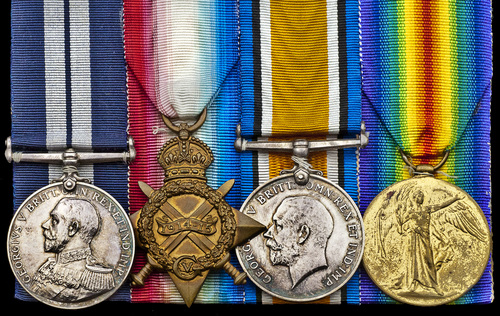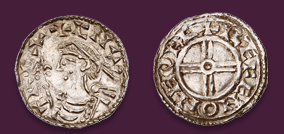
Auction: 15002 - Orders, Decorations, Campaign Medals and Militaria
Lot: 25
The Superb and Well Documented Great War 'Lake Tanganyika' D.S.M. Group of Four to Chief Petty Officer W. 'Brum' Waterhouse, Royal Navy, The Senior Rating For Spicer-Simson's Epic Trek Across the Wilds of Africa, To Ultimately Gain Naval Supremacy For Britain in Central Africa
a) Distinguished Service Medal, G.V.R. (180131. W. Waterhouse, Act. C.P.O. Tanganyika Nl. Expn.)
b) 1914-15 Star (180131 W. Waterhouse, P.O., R.N.)
c) British War and Victory Medals (180131 W. Waterhouse. C.P.O. R.N.), good very fine, together with the following related items:
- The recipient’s original handwritten diary from the Tanganyika Naval Expedition, bound in leather with 'W. Waterhouse' written in ink on the cover, the pencilled entries covering many of the salient episodes of the Tanganyika Expedition, but also including nominal rolls and expenditure details
- An “Army & Navy Film and Print Wallet’, the outer cover with pencilled name, ‘Capt. Spicer-Simson’, and the interior containing around 30 photographs taken on the expedition, quite a few of them with pencilled captions to reverse, very probably in Spicer-Simson’s own hand, this important photographic archive since discovered and added to the collection by Ron Penhall
- (2) Copies of The London Illustrated News, featuring the expedition, dated 20.5.1916 and 3.6.1916
- Copy of National Geographic Magazine, featuring the expedition, dated October 1922
- (3) Books relating to the expedition: The Phantom Flotilla, Peter Shankland; Utmost Fish, H.W. McCann and Mimi And Tou-Tou Go Forth, G. Foden (lot)
D.S.M. London Gazette 11.4.1916 Actg. Chief Petty Officer W. Waterhouse, RN
'For services in connection with the Tanganyika Naval Expedition.’
In the summer of 1915, the key to success in Central Africa lay in the overwhelming German supremacy on Lake Tanganyika. Just how this was challenged by a force of two gunboats - the Mimi and Tou-Tou - commanded by an eccentric Naval Officer with a talent for public relations is one of the most extraordinary stories of the whole War - indeed no single achievement during that conflict was distinguished by more bizarre features than the successfully executed undertaking of 28 daring men who transported a ‘ready-made’ Navy overland through the wilds of Africa to destroy this enemy flotilla in control of Lake Tanganyika.
William Waterhouse was among the first chosen to join this famous expedition and, as an Acting Chief Petty Officer, commanded the ratings similarly employed. He was, in fact, involved in the early trials of the boats on the River Thames, the whole under the direction of Commander G. Spicer-Simson, R.N. - the man with the talent for public relations. The Phantom Flotila takes up the story:
‘It was arranged that the main party should sail for Cape Town on 15 June in the Llandstephen Castle, and that the boats should proceed to Tilbury to be shipped on the 9th or 10th latest. But first Spicer-Simson, with some difficulty, obtained permission for H.M.S. Mimi to fire one round into Messrs. Thorneycroft’s old dock at Chiswick on the Thames. He sent for his Chief Gunlayer, Chief Petty Officer James [sic] Waterhouse, to discuss the test. Waterhouse was an ideal C.P.O. - efficient, dignified, imperturbable. He never divulged, even by the flicker of an eyelid, what he thought of the outfit he found himself in. He was sworn to secrecy in Spicer-Simson’s office at the Admiralty, and then told the object and destination of the expedition. He wasn’t at all surprised because the retired Petty Officer doorman had asked him on his way in if he was one of the Tanganyika Party for Africa.
The test took place on 8 June. C.P.O. Waterhouse, aware that it was a test of his skill as well as of the gun and of Mimi’s stability, took careful aim and fired while the two boats were going at full speed up the river. The shell sped true to its mark, and at the same instant both gun and gunlayer shot overboard in the opposite direction because the brass locking ring had not been properly secured. Fortunately both were fished out again unharmed. The test was evidently considered a success, for on the following day the boats were taken down to Tilbury...’
To cover the three thousand miles or so that lay between Cape Town and the Lake, the boats had to be hauled by steam traction engines and ox trains over more than 100 miles of extremely wild and difficult country, where there were no roads or communications of any kind. The whole journey, by barely navigable rivers and narrow-gauge railways, through country where sleep-sickness and other horrible diseases were rife, is one of the strangest passages in the history of the Royal Navy. By 23rd December 1915, however, the Mimi and Tou-Tou had been successfully launched on the Lake, and three days later they went into action.
It was on Boxing Day, which also happened to be a Sunday, and during the usual church service Spicer-Simson received a message of the impending arrival of the German ship Kingani. Coolly placing the note in his pocket, he returned his attention to the ongoing service, even though his officers - who were facing the Lake - could by now see the approaching enemy vessel. Much to the latter’s relief the service finally came to an end, and, having held up a hand to indicate that the men were not to be dismissed, Spicer-Simson took a long look at the approaching gunboat. Then he said, in a cool, clear voice, “Chief Petty Officer Waterhouse! You may dismiss the divisions - and man the launches for immediate action!”
Waterhouse quickly reported to his station at the gun in Spicer-Simson’s command, the Mimi, while Petty Officer Flynn did likewise in Lieutenant Dudley’s command, the Tou-Tou - Dudley was Royal Naval Reserve. And in the action that ensued, it was generally accepted that it was Flynn in the Tou-Tou who scored the winning hits that resulted in the capture of the Kingani - shortly to be taken on the strength of the Royal Navy’s little flotilla and renamed Fifi, the first such enemy vessel to undergo such transformation in the War thus far. In any event, back on shore, Waterhouse sportingly agreed that it was indeed the case that Flynn’s gunnery had won the day, or certainly his final hit, but his observations were quickly corrected by an irritated Spicer-Simson “Certainly not! Petty Officer Flynn couldn’t possibly have scored a hit without a qualified naval officer to spot for him and give him the ranges.” Everyone turned to Flynn, who commented dryly, “Brum Waterhouse can have all the hits, Sir. I am happy so long as none of them hit me.”
On 9th February 1916, Waterhouse and another Petty Officer manned the gun on the Fifi, under Spicer-Simson, in a hotly contested engagement with the Hedwig von Wissman, the whole in the company of the Mimi under Lieutenant Wainwright. And of this running fight of three hours’ duration, Waterhouse wrote in his diary:
‘Our first hit from the Fifi’s 12-pounder exploded in the engine room, killing two and wounding one, all whites. Apparently after that all the whites that were left must have left the ship and left the ten blacks aboard; but we did not know and carried on firing till we saw someone waving a white flag. Then we ceased to fire but we had done our work very well, and she was on fire and sinking fast. She went down head first and looked a pretty sight sinking. We signalled to Mimi to rescue the blacks, for it was only then that we caught sight of all the whites away to port, for they had left their ship one hour, or about that, before she sank and left the colours flying and the poor niggers to keep them flying (Brave Germans).’
It would have been doubly satisfactory if the third and largest of the German ships - the Graf von Gotzen - could have been accounted for by the British Flotilla, but she did not risk an engagement. After being bombed by a Belgian aeroplane, she was scuttled by the Germans in Kigoma Harbour, on the eastern shore of the Lake. So ended Germany’s command of Tanganyika. Apart from the material loss inflicted on the enemy, the success of the Naval Expedition did much to enhance British prestige among the locals, not only in the immediate neighbourhood of the Lake, but in the northern districts of Rhodesia and in adjacent German territory.
In consequence of the great success of the expedition, Spicer-Simson was awarded the D.S.O., three officers the D.S.C., and 12 ratings the D.S.M., among the latter C.P.O. Waterhouse.
Although C. S. Forester’s famous novel The African Queen has a somewhat different story line, it was undoubtedly inspired by the Lake Tanganyika Expedition of 1915-16. So, too, of course, the subsequent Oscar-winning film starring Humphrey Bogart.
Provenance: Douglas-Morris Collection, October 1996
Ron Penhall Collection, September 2006
Subject to 20% VAT on Buyer’s Premium. For more information please view Terms and Conditions for Buyers.
Sold for
£17,000




